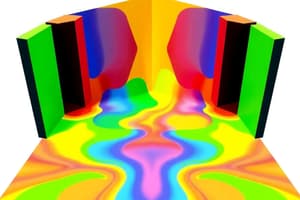Podcast
Questions and Answers
Which characteristic primarily distinguishes orthographic, oblique, and perspective projection systems from one another?
Which characteristic primarily distinguishes orthographic, oblique, and perspective projection systems from one another?
- The software used to create the projection.
- The complexity of mathematical equations required for their creation.
- The angle at which projectors strike the picture plane and their relationship to each other. (correct)
- The color palette used in the final rendered image.
Why is understanding the principles of different projection systems crucial in technical drawing?
Why is understanding the principles of different projection systems crucial in technical drawing?
- It establishes a common language for interpreting and creating technical drawings. (correct)
- It is required for operating specific CAD software.
- It simplifies the process of converting 2D drawings into 3D models.
- It allows artists to create more aesthetically pleasing drawings.
What is the primary function of 'projectors' in the context of pictorial systems?
What is the primary function of 'projectors' in the context of pictorial systems?
- To create shadows and highlights in the drawing.
- To extend points from a 3D object to a 2D picture plane. (correct)
- To illuminate the drawing surface for better visibility.
- To measure the angles and dimensions of the object being drawn.
How does projection drawing contribute to spatial reasoning skills?
How does projection drawing contribute to spatial reasoning skills?
Which of the following fields of study is closely associated with projection drawing, providing a framework for locating points and defining geometric elements in space?
Which of the following fields of study is closely associated with projection drawing, providing a framework for locating points and defining geometric elements in space?
Flashcards
Projection
Projection
Representing a 3D object by extending its points with straight lines to a picture plane.
Picture Plane
Picture Plane
An imaginary, transparent plane where the 3D object is represented; also known as the plane of projection.
Projectors
Projectors
Straight lines extending from the object to the picture plane in a projection.
Orthographic Projection
Orthographic Projection
Signup and view all the flashcards
Spatial Thinking via Projection
Spatial Thinking via Projection
Signup and view all the flashcards
Study Notes
- Drawing systems are classified by projection method and pictorial effect.
- Projection represents a 3D object by extending its points with straight lines (projectors) to a picture plane.
- The picture plane is an imaginary transparent plane, also known as the plane of projection.
- Orthographic, oblique, and perspective projection are the three main types of projection systems.
- The relationship of projectors to each other and their angle to the picture plane distinguishes each system.
- Understanding these projection systems allows comprehension of various drawing types.
- Projection drawing serves as a communication tool and enhances spatial thinking in 3D.
- Constructing a projection involves navigating a 3D space to locate points and determine lines and planes.
- Projection drawing incorporates Cartesian coordinates and descriptive geometry principles.
Studying That Suits You
Use AI to generate personalized quizzes and flashcards to suit your learning preferences.




